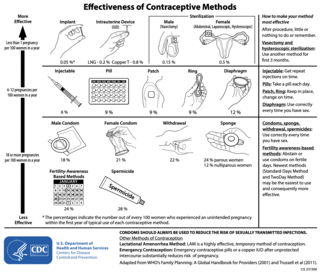
A condom is a sheath-shaped barrier device used during sexual intercourse to reduce the probability of pregnancy or a sexually transmitted infection (STI). There are both external (male) and internal (female) condoms.

Sexual intercourse is sexual activity involving the insertion and thrusting of the male penis inside the female vagina for sexual pleasure, reproduction, or both. This is also known as vaginal intercourse or vaginal sex. Sexual penetration has been known by humans since the dawn of time, and has been an instinctive form of sexual behaviour and psychology among humans. Other forms of penetrative sexual intercourse include anal sex, oral sex, fingering and penetration by use of a dildo, and vibrators. These activities involve physical intimacy between two or more people and are usually used among humans solely for physical or emotional pleasure. They can contribute to human bonding.

Safe sex is sexual activity using methods or contraceptive devices to reduce the risk of transmitting or acquiring sexually transmitted infections (STIs), especially HIV. "Safe sex" is also sometimes referred to as safer sex or protected sex to indicate that some safe sex practices do not eliminate STI risks. It is also sometimes used colloquially to describe methods aimed at preventing pregnancy that may or may not also lower STI risks.

A sex toy is an object or device that is primarily used to facilitate sexual pleasure, such as a dildo, artificial vagina or vibrator. Many popular sex toys are designed to resemble human genitals, and may be vibrating or non-vibrating. The term sex toy can also include BDSM apparatus and sex furniture such as sex swings; however, it is not applied to items such as birth control, pornography, or condoms. Alternative terms for sex toy include adult toy and the dated euphemism marital aid. Marital aid also has a broader meaning and is applied to drugs and herbs marketed to enhance or prolong sex.

A tampon is a menstrual product designed to absorb blood and vaginal secretions by insertion into the vagina during menstruation. Unlike a pad, it is placed internally, inside of the vaginal canal. Once inserted correctly, a tampon is held in place by the vagina and expands as it soaks up menstrual blood. However, in addition to menstrual blood, the tampon also absorbs the vagina's natural lubrication and bacteria, which can change the normal pH, increasing the risk of infections from the bacterium Staphylococcus aureus, which can lead to toxic shock syndrome (TSS). TSS is a rare but life-threatening infection that requires immediate medical attention.

Cervicitis is inflammation of the uterine cervix. Cervicitis in women has many features in common with urethritis in men and many cases are caused by sexually transmitted infections. Non-infectious causes of cervicitis can include intrauterine devices, contraceptive diaphragms, and allergic reactions to spermicides or latex condoms. Cervicitis affects over half of all women during their adult life.

The cervical cap is a form of barrier contraception. A cervical cap fits over the cervix and blocks sperm from entering the uterus through the external orifice of the uterus, called the os.

Vaginal lubrication is a naturally produced fluid that lubricates the vagina. Vaginal lubrication is always present, but production increases significantly near ovulation and during sexual arousal in anticipation of sexual intercourse. Vaginal dryness is the condition in which this lubrication is insufficient, and sometimes artificial lubricants are used to augment it. Without sufficient lubrication, sexual intercourse can be painful. The vaginal lining has no glands, and therefore the vagina must rely on other methods of lubrication. Plasma from vaginal walls due to vascular engorgement is considered to be the chief lubrication source, and the Bartholin's glands, located slightly below and to the left and right of the introitus, also secrete mucus to augment vaginal-wall secretions. Near ovulation, cervical mucus provides additional lubrication.

Personal lubricants are specialized lubricants used during sexual acts, such as intercourse and masturbation, to reduce friction to or between the penis and vagina, anus or other body parts or applied to sex toys to reduce friction or to ease penetration. Surgical or medical lubricants or gels, which are similar to personal lubricants but not usually referred to or labelled as "personal" lubricants, may be used for medical purposes such as speculum insertion or introduction of a catheter. The primary difference between personal and surgical lubricants is that surgical lubricants are thicker, sterile gels, typically containing a bacteriostatic agent. As of 2015, the personal lubricant market was estimated to be worth at least $400 million.

There are many methods of birth control that vary in requirements, side effects, and effectiveness. As the technology, education, and awareness about contraception has evolved, new contraception methods have been theorized and put in application. Although no method of birth control is ideal for every user, some methods remain more effective, affordable or intrusive than others. Outlined here are the different types of barrier methods, hormonal methods, various methods including spermicides, emergency contraceptives, and surgical methods and a comparison between them.

Rape is a type of sexual assault involving sexual intercourse or other forms of sexual penetration carried out against a person without their consent. The act may be carried out by physical force, coercion, abuse of authority, or against a person who is incapable of giving valid consent, such as one who is unconscious, incapacitated, has an intellectual disability, or is below the legal age of consent. The term rape is sometimes used interchangeably with the term sexual assault.

A female condom is a barrier device that is used during sexual intercourse as a barrier contraceptive to reduce the probability of pregnancy or sexually transmitted infection (STI). It is inserted in the vagina or anus before intercourse to reduce the risk of exposure to semen or other body fluids. The female condom was invented by Danish MD Lasse Hessel in 1990 and approved by the FDA for sale in the US in 1993.

Condom effectiveness is how effective condoms are at preventing STDs and pregnancy. Correctly using male condoms and other barriers like female condoms and dental dams, every time, can reduce the risk of sexually transmitted infections (STIs), including human immunodeficiency virus (HIV) and viral hepatitis. They can also provide protection against other diseases that may be transmitted through sex like Zika and Ebola. Using male or female condoms correctly, every time, can also help prevent pregnancy.

A sexually transmitted infection (STI), also referred to as a sexually transmitted disease (STD) and the older term venereal disease (VD), is an infection that is spread by sexual activity, especially vaginal intercourse, anal sex, oral sex, or sometimes manual sex. STIs often do not initially cause symptoms, which results in a risk of passing the infection on to others. Symptoms and signs of STIs may include vaginal discharge, penile discharge, ulcers on or around the genitals, and pelvic pain. Some STIs can cause infertility.

Human female sexuality encompasses a broad range of behaviors and processes, including female sexual identity and sexual behavior, the physiological, psychological, social, cultural, political, and spiritual or religious aspects of sexual activity. Various aspects and dimensions of female sexuality, as a part of human sexuality, have also been addressed by principles of ethics, morality, and theology. In almost any historical era and culture, the arts, including literary and visual arts, as well as popular culture, present a substantial portion of a given society's views on human sexuality, which includes both implicit (covert) and explicit (overt) aspects and manifestations of feminine sexuality and behavior.

An artificial vagina is a device designed to imitate the vagina as well as sometimes the vulva. To achieve this, it will generally be made of a soft material, lubricated, and occasionally heated.
A conception device is a medical device which is used to assist in the achievement of a pregnancy, often, but not always, by means other than sexual intercourse. This article deals exclusively with conception devices for human reproduction.

Vagina dentata describes a folk tale in which a woman's vagina is said to contain teeth, with the associated implication that sexual intercourse might result in injury, emasculation, or castration for the man involved. The topic of "vagina dentata" may also cover a rare medical condition affecting the vagina, in which case it is more accurately termed a vaginal dermoid cyst.
A prototype spray-on condom was invented by Jan Vinzenz Krause of the Institute for Condom Consultancy in 2006. The idea was inspired by the mechanics of a drive-through car wash—the penis was inserted into a chamber where nozzles apply a coat of fast-drying liquid latex. The process took close to a minute, a restriction that has kept the product off the market. The product was expected to cost around twice as much as a traditional condom. Prototypes consisted of an application chamber and a cartridge of liquid that produces around 20 condoms, depending on penis size.
The following outline is provided as an overview of and topical guide to human sexuality:

















